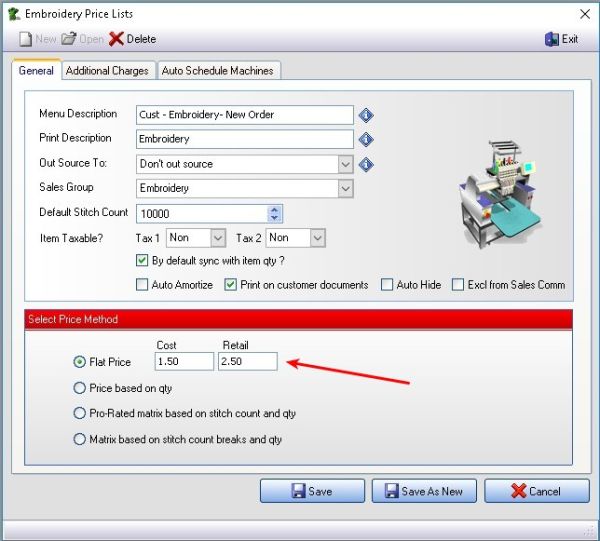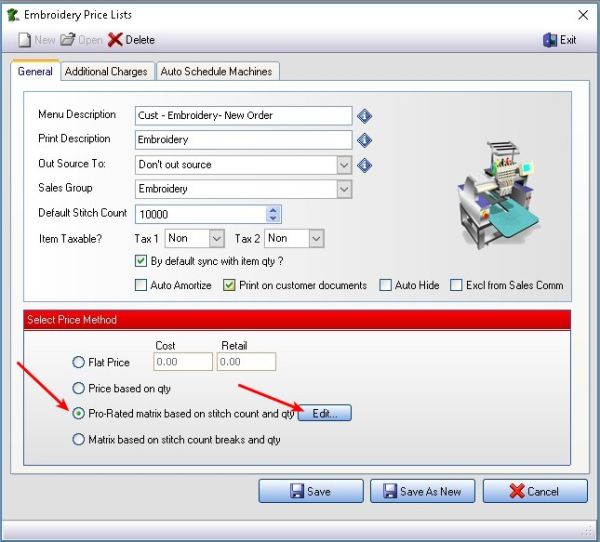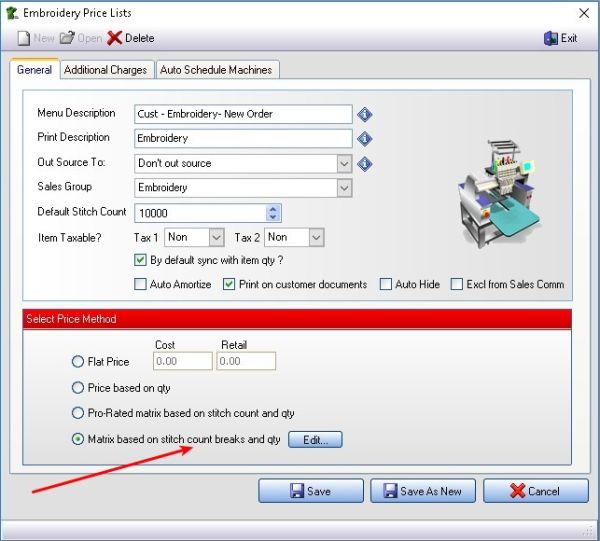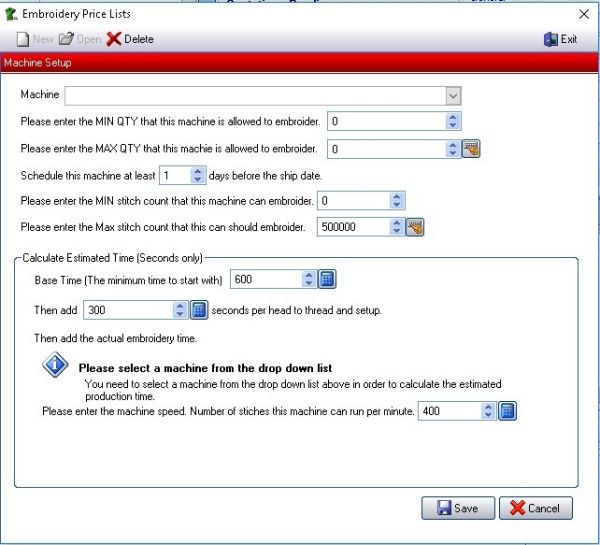meta data for this page
- en
Embroidery Price List
Your Embroidery price list can consist of any number of items, each of which can use any of the 4 different pricing “methods”
- To create or edit an Embroidery item, go to:
Edit -> Embroidery Prices
- To edit an existing entry on this price list, Double click on it
- or click on the
Newbutton to create a new item
- You will see 3 tabs:
GeneralAdditional ChargesAutoschedule Machines
General Tab
Menu Description - represents the actual caption of the pop-up menu which appears when you click on the Add Embroidery button, in the sales screen.
Print Description - is the default description that will print on your quotations, work orders and invoices. You can at any time override this description within the sales screen.
Out Source To - If you are planning to out source the embroidery to another contract embroiderer then select the supplier you want to out source it to from the drop down list. FastManager will then automatically add it to the purchase order wizard.
Sales Group - this will determine under which sales group FastManager will group all sales of this price list. It also determines which item code FastManager will select in QuickBooks when exporting the invoice.
Default Stitch Count - this is the default stitch count that FastManager will use to calculate the selling price. You can change it on the fly when entering a sales order.
Price Method
There are 4 embroidery pricing methods to choose from:
- Flat Price
- Price based on on quantity
- Base price which includes a certain number of stitches + an additional charge per 1000 stitches.
- Flat price based on quantity and within a certain stitch count range.
You need to select which method you want to use to price out embroidery on this price list. You will then see an Edit button that you can click on which will open another window where you can enter your price matrix.
Flat Price
If you select the Flat Price option you simply need to enter the cost and retail price of your embroidery. This is a very basic flat rate system and the price does not fluctuate
- This method will simply do a lookup based on the number of embroideries that you do. Stitch count does not play a role when determining the selling price.
Price Based on Quantity
You can select to enter both the cost and retail or calculate either by selecting the appropriate option from the top.
Enter:
- Both cost and retail:
- With this setting you will manually enter both the cost price and the retail price for each quantity break.
- FastManager will not calculate either of those for you, but will use whatever you have entered.
- Cost and calculate retail:
- With this setting you will enter your cost prices and a
markuppercentage. - Then click on
Re-Calculateand FastManager will calculate the retail (selling) prices for you
- Retail and calculate cost:
- With this setting you will enter your own Retail pricing as well as a
margin(percentage) - Then click on
Re-Calculateand FastManager will calculate the cost prices for you, based on the desired margin
Re-Calculate button to refresh your prices if you alternate between calculating methods.
Pro-rated matrix
Pro-rated matrix based on stitch count and quantity
This option will start a look up and then calculate a selling price based on the quantity and number of stitches on the embellishment.
First you will enter a base price that will include a specified number of stitches and then add a pro-rated amount per thousand stitches, to be added if the stitch count is higher than the initial number of stitches included.
For example:
- Enter an inclusive number of stitches (say: 5000) under
Stitches Incland a selling amount underRetail, let's say: $5.50- Now, if the number of stitches on the design is anywhere between 0 and 5000, the price will be the same: $5.50
- Then, enter a rate in the
Rate per thousandcolumn, let's say: $0.70 (we are adding 70 cents per 1000 stitches above the initial 5000)- If the stitch count on the order is more than 5000, FastManager will round up the stitch count to 6000 and charge $5.70
- If the stitch count on the order is more than 6000, FastManager will round up the stitch count to 7000 and charge $6.40
Matrix Based On Stitch Count Breaks And Quantity
This matrix works well if you charge a flat rate if the stitch count falls within a specified range.
- For example: On a quantity of
12, if the stitch count is anywhere between2000 and 4999stitches then the selling price will be$5.00
- Whether the stitch count is
2300or4500you will still charge$5.00(with different rates being charged within different stitch count ranges)
Start by entering the total number of Stitch count breaks you will have (the number can easily be changed later, but you need at least 2 for this to work)
- If you select:
Both cost and retail-- then you must manually fill out both the
Your Retailand theYour Costtabs
- If you select:
Cost and calculate retail-- fill out the
Your Costtab (including theMarkupcolumn) and click onRe-Calculateto populate the Retail tab
- If you select:
Retail and calculate cost-- fill out the
Your Retailtab (including theMargincolumn) and click onRe-Calculateto populate the Cost tab
Next, on the Your Retail tab - click on the column header: click to edit and enter 0 as the first stitch count break.
0
Then enter the next stitch count break in the 2nd column, 3rd column, and so on
Now enter the selling price on the first row under each of those columns
Then you can proceed to enter quantity breaks under the Qty columnn with corresponding selling prices in each “stitch-count break” column.
Any stitch count between 1000 and 1999 will be charged at $1.00 (for qty's below 48)
Additional Charges
You can add an unlimited number of additional charges such as digitizing, artwork, bagging and special thread colors etc.
Click on the Additional Charges Tab
- To create a new additional charge, click on the
Addbutton - To edit an existing charge, select the charge from the list below, and click on the
Editbutton. - To delete an existing charge, select the charge from the list below, and click on the
Deletebutton.
1.) Defaults (can be overridden on the order)
Select if you want FastManager to add this additional charge to the sales screen by default.
- You can always remove or add it on the fly from the sales screen, by deleting the row, or right clicking on the actual embroidery line item and select
Additional Charges
However
If the additional charge is something that you won't charge on a regular basis then it might be better to add these items on the fly later as it could become time consuming to delete these rows every time.
2.)Basic Settings
Next enter a user friendly menu description.
- This is the description that will display when you add this charge on the fly, by right clicking on the embroidery charge line in your sales screen and select 'Additional Charges'
Then enter the default print description. This is the description that will print on your quotations, work orders and invoices. You can over type this description in the sales screen.
If you are out sourcing this additional charge check the 'Out source to' check box and select a default vendor from the drop down list. FastManager will add this item to your PO wizard if this option is selected.
- This is a default setting - the supplier can be changed on the order or on the PO.
You can have FastManager sync the number of items, by default, with the number of colors or items if you like.
3.) Cost & Selling price
Enter your cost and selling price
The cost has a twofold purpose:
- If you are out-sourcing this service to another vendor then FastManager will use this cost table when generating a PO
- FastManager will also use this cost to calculate the estimated profit on your work order.
4.) Tax settings
Select if the line item should be taxed or not.
Tax 2 will almost always be Non - don't change this unless you have a good reason to do so
5.) Scheduling Options (only relevant if you have the Scheduling module enabled)
If you are using the auto scheduling module, you can select if you want FastManager to automatically create a task or simply add additional time to your machine if this charge is present as a line item in your work order.
Digitizing you may want to create a task for your art department. If this additional charge is
Metallic Thread you may simply want to add an additional 30 seconds per garment to your machine time.
If you are creating an additional task you can also specify when you want FastManager to schedule it.
When complete, click on the Save button to commit your changes.
Open any existing item, then simply give it a new name and click on
Save As New
Auto Scheduling Machines
Scheduling → Embroidery Machines
If you want to make use of FastManager's auto scheduling module you need to tell FastManager how to select and schedule a machine when using this embroidery item.
Click on the Auto Schedule Machines tab.
- From here you will tell FastManager which of your machines are capable of doing this particular type of embroidery.
- For example: you would probably not want to include your 12 head machine if this embroidery item is called 'Names'.
For example: you would not want to run any job under 2000 stitches on the 12 head machine as the machine will complete the job before you are done hooping for the next round.
To edit an existing machine, select the machine from the list below, and click on the Edit button.
To delete and existing machine from this price list, select the machine from the list below, and click on the Delete button
To add a new machine, click on the Add button.
\
Once you click on either Edit or Add , you should see this screen:
Machine Setup
From the drop down list select the machine that you want to include in the list of machines that can accommodate this price list.
- Enter the min qty that this machine is allowed to run.
- FastManager will automatically eliminate this machine when trying to schedule this job if the min qty is not met.
- Enter the max qty that this press is allowed to run.
- FastManager will automatically eliminate this machine when trying to schedule this job if the max number of pieces are exceeded.
- Then select the minimum number of days prior to the Ship Date you want FastManager to search for an open slot to run this machine.
The number of days it will try is based on the number of days you enter in here. The higher the number the higher the probability that FastManager will see the job as do-able. However you will have less time to complete the art and get the goods in.
3 is normally a good number.
- Select the min and max number of stitches that this machine can run.
Calculating Production Time
We now need to tell FastManager how it is going to calculate production time for this machine.
For example:
If this price list is 'Embroidering Caps' then you will have different times than if this price list was 'Embroidering Polos'.
First we need to enter a base time.
This would be the minimum time that you want to schedule a job for and FastManager will start with the base time. This would basically include how long it takes to get the shirts, thread and backing to the machine. This does NOT include setup and break down time.
Next we need to enter the setup and break down time.
This time is calculated “per head”. Thus FastManager will multiply the time with the number of heads, and then add it to the base time.
For example:
If you want to enter 7 minutes for the base time then you would click on the calculator button and select 5 min and then click on the calculator button again and select 2 min.
Next you need to select your machine speed - how many stitches can this machine run per minute.
Bear in mind that this number could change depending on the type of embroidery, specifically: the type of embroidery that this particular pricelist item is being setup for.
Click on the Save button when you are done.









